
Rome, beautiful Rome! Is there anything I can say about the Eternal City that hasn’t been said before? No, but I won’t let that stop me trying. It was fantastic both in the sense of great and in the sense of unbelievable — it’s almost hard to believe I really was there. But I have the photos to prove to myself that I didn’t just imagine it all.

One of the first things I noticed was the way that SPQR (Senatus Populusque Romanus, ‘the Senate and people of Rome) is plastered across every lamppost, rubbish bin, etc. The Empire ended some time ago so it seems a bit anachronistic to me …

My first ‘big’ sight on my first day in Rome: the Trevi Fountain. It looks far more impressive in real life than it does on posters on the walls of cheap Italian restaurants, that’s for sure. It’s huge, and the way it dominates a small piazza makes it seem even bigger.

I loved the rocks over which the water tumbles, they seemed both artful and natural at once. They and the rest of the fountain were made in the mid-18th century, to mark the terminus of one of the main aqueducts into Rome. Apparently the water is very pure — I assumed it must have been liberally dosed with chlorine!

The Spanish Steps. Luckily, you don’t have to be Spanish to use them.

From half-way up the Steps, looking down the Via Condotti (i.e. in the opposite direction to the above photo), a very fashionable shopping district. Lucky I didn’t try to walk down it then, or I’d probably have been arrested by the fashion polizia.

This was taken from somewhere on the Pincian Hill, looking past a fountain towards some church or other.
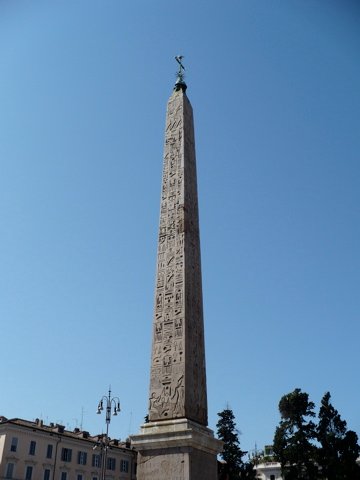
An Egyptian obelisk, in Rome? Yes, and it’s not the only one, either. They’re all over the place, in fact. This one is the obelisco Flaminio in the Piazza del Popolo. It’s from the reign of Rameses II, from Heliopolis, and during the reign of Augustus was brought to Rome to stand in the Circus Maximus. It rather puts Cleopatra’s Needle to shame!

Some church (not the same some church as above, although I think that church is nearby) in the Piazza Augusto Imperatore (where the Mausoleum of Augustus is, though that’s not particularly interesting to look at, as it’s currently closed). There are a lot of churches in Rome. (Not so many chapels, synagogues, mosques or temples.) I honestly don’t know what they do with them all! The following day was a Sunday, but I didn’t see much evidence of them filling up with parishioners.
Update: By chance, I came across an account of the opening of the Ara Pacis in the Times of 1938, and it has a little map … so I now know that the church is San Rocco.

Also in the Piazza is a Fascist-era building, with a frieze celebrating the technology of war: early modern-era weapons on the left, modern ones (e.g. machine guns) on the right.

My first ‘wow … just, wow’ moment of the day. According to the Res Gestae Divi Augusti, a record of the achievements of the emperor Augustus written late in his life,
When I returned to Rome from Gaul and from Spain, in the consulship of Tiberius Nero and Publius Quintilio, having brought to a satisfactory finish my works in these provinces, the Senate decreed that there should be consecrated in the Field of Mars an altar to the Augustan Peace and ordered that the officials, priests and vestal virgins should celebrate a sacrifice at it every year.
And this is that altar: the Ara Pacis, or Altar of Peace (also now in the Piazza Augusto Imperatore), dedicated in 9 BC. Or at least some of it is — much of it is a modern reconstruction, as only fragments have been found. But what fragments!
(Oh, the mannequins in the dresses? There was some sort of retrospective fashion exhibition in the Museo dell’Ara Pacis, that is to say, modern fashion. I can’t blame Italians for wanting to point out that they didn’t just die out at the end of the 18th century … but still: not interested.)
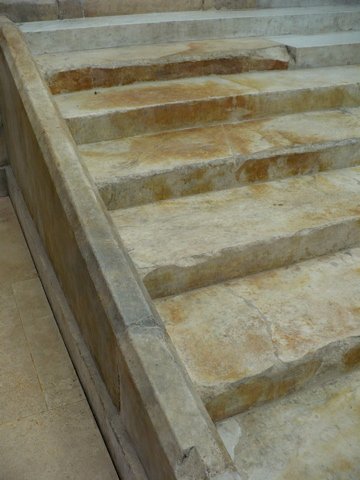
Start with the steps. Well, they’re only steps … but steps that Augustus himself probably climbed. Or am I assuming too much? Maybe he wasn’t allowed inside the altar, just the priests? (The Romans did have some odd superstitions. Then again, he was Pontifex Maximus …) Or maybe he didn’t turn up at all because he had an empire to run? Or maybe they were replaced a couple of centuries later due to wear and tear. Oh well.
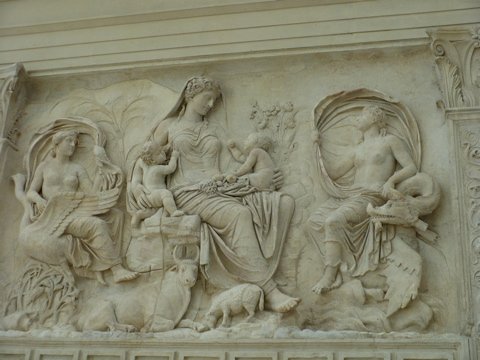
How about this fragment then, on the east exterior. The identity of the figures is disputed. The one in the middle could be Tellus, Italia, Venus (ancestor of the Julii), or the Pax Augusta herself (which seems most likely to me, but then I’m just a tourist). She is dandling two putti (NOT cherubs, as I discovered about 1 minute ago), which along with the plants, fruit and animals refer to fecundity and plenty, and then on either side are figures representing the winds. Why the winds? For their importance for maritime trade, perhaps?

On the south side is a long panel showing a procession of people, priests, lictors and Augustus himself. In the photo above can be seen Agrippa, Augustus’ close friend and advisor; either Livia, Augustus’ wife, or Julia, Agrippa’s; and between them, Agrippa and Julia’s son (and Augustus’ grandson), Gaius. He, along with his older half-brother Lucius, was adopted by Augustus so that they would be his heirs. But first Lucius and then Gaius died in their twenties, while Augustus was still alive, and so Tiberius (Augustus’ stepson) eventually became emperor. It’s impossible to know if the Julio-Agrippans would have been any better than the Julio-Claudians, but they could hardly have been worse.

Another family group: here we see Germanicus holding the hand of Antonia, his mother, and behind him is his father, Drusus. Germanicus was another might-have-been-emperor: he was an excellent general, like his father, but died in suspicious circumstances, perhaps due to the jealousy of his uncle Tiberius, who was then emperor. However, his son Gaius — Caligula — succeeded Tiberius, and his brother Claudius succeeded Caligula, so his part of the family got to have their turn.

After leaving the Ara Pacis, I headed south along the Tiber, where I saw this building. It looks like somebody has ripped out the twin fasces symbols from either side of the facade (the keystone over the arch is also damaged). But they didn’t bother to plaster over the holes left behind. This strikes me as quite apt. All over Rome, there are ancient sites and monuments with signs saying that this area was first excavated in 1928-35 (say), or underwent major renovations in 1934-7. But they never say who or what was responsible for all this interest in the Roman past during the 1920s and 1930s. So Fascism is often only detectable by the holes it left behind.
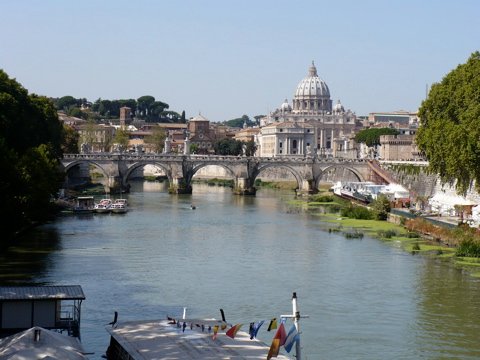
Speaking of the Tiber, here it is. I hate to say it, but it’s not one of the world’s great rivers. It’s sluggish, dirty and smelly. At least it was when I was there, at the start of autumn. But still: what a view! The bridge is the Ponte Sant’Angelo, and behind that is the dome of St Peter’s.

The Pont Sant’Angelo leads, naturally enough, to the Castel Sant’Angelo.

This bridge was built in the 130s! So it’s only a quarter-century short of 1900 years old, and still bearing traffic across the Tiber. The castle was built at the same time — although it wasn’t originally a castle, but Hadrian’s mausoleum. Every emperor from Hadrian to Caracalla was buried there. Under the emperor Honorius, the mausoleum was made part of Rome’s defences, though it was itself looted in 410 by the Visigoths and again in 537 by the Ostrogoths. The popes used it into a fortress (Clement VII sheltered here during the sack of Rome in 1527) and a prison (Giordano Bruno stayed here). Now it’s a museum, although sadly I didn’t visit it as I could see one of my major objectives of the day, St Peter’s Basilica (as shown in the photo at the top of the post).
Even 75 years ago, I wouldn’t have been able to see it from near the Castel Sant’Angelo, however, as the view was blocked by a jumble of old palaces and churches. To celebrate the signing of the Lateran Treaties, Mussolini knocked them down and built the Via della Conciliazione. It’s still controversial, and understandably so — but the view down it is magnificent.

After trekking all that way, I finally made it to St Peter’s Square. Here I am at the back of the queue to go through the security screening (about where the white square is, I think) — there’s another queue beyond that to get into the basilica etc. Actually, I can’t remember if there was security screening, but there was definitely modesty screening: no shoulders, no knees, no belly buttons, no cleavage. These things are evidently not part of God’s plan.

Still, despite the length of the line, it moved relatively quickly … less than 20 minutes total, which was good because it was now about noon and getting warm. Here I’m a lot closer to getting somewhere. In fact, I’m so close to the basilica that the dome, which is set quite far back, isn’t visible at all. It’s actually a lot more striking from a distance than up close.
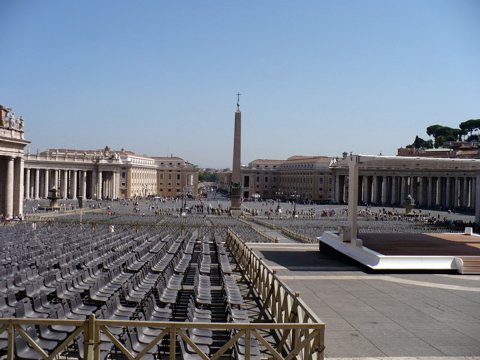
This was taken near the door to the basilica, looking back towards Castel Sant’Angelo. It shows just how vast St Peter’s Square is. The canopy is presumably where the Pope stands when addressing the multitudes sitting in all those chairs. And yes, that’s another Egyptian obelisk, 13th century BC this time. During Caligula’s reign it was in a nearby circus, which may have been where St Peter was martyred. It was moved here in the 16th century.
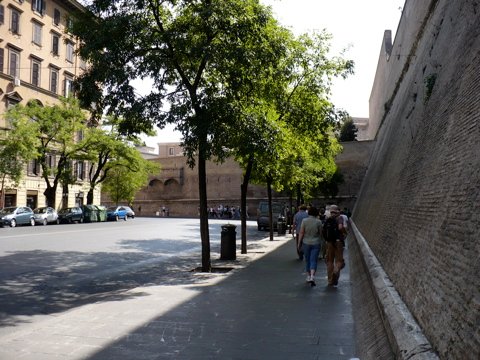
Hmmm, this isn’t St Peter’s. What’s going on here? Well … one of the things I wanted to see was the Sistine Chapel. And the Vatican Museum too. As do most visitors to the Vatican, I’m sure. The problem was that I was in Rome on a weekend, and both the chapel and the museum were open only on the Saturday morning. I was well aware of this, but when I stood at the back of that long queue, I thought that was the line to get into the chapel, because on my map it was marked very close to the basilica. Well, it probably is, but the entrance to the chapel (by way of the museum) is actually a quarter of the way around the Vatican. It may be the world’s smallest country, but by the time I’d realised my mistake I think I had about 10 minutes to get there and I missed it by less than 5. So I took this photo while I was trudging along the walls back to St Peter’s, feeling drained because of my sudden adrenalin burst and dejected because I’d missed out on seeing the Sistine Chapel. I mean, that’s like going to London and not seeing the Tower …

Then I figuratively slapped myself upside the head. I was in Rome! It’s not like there’s nothing else to see and do. So I went and stood in the queue again, and went inside the basilica — actually, down into the crypt below. I took this photo of the tomb of John Paul II, but obviously I wasn’t meant to … never fear, there’s a webcam !
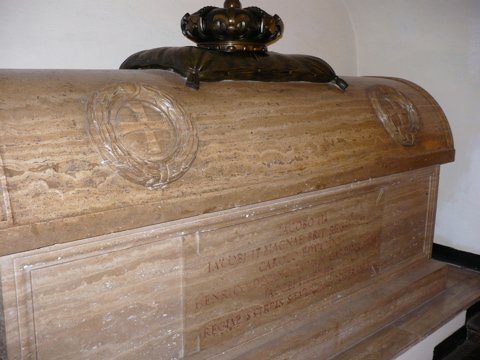
Also in the crypt is the tomb of a king of Great Britain: James III. I was surprised, because there wasn’t a James III. OK, so obviously he’s the Old Pretender. But I was still surprised — what’s he doing under St Peter’s? It turns out that his younger son, Henry Benedict Stuart, became a cardinal in the Catholic Church — though he still styled himself Duke of York and Henry IX. So presumably he pulled strings to get himself, his father and his brother (Bonnie Prince Charlie — they’re all in there) a prime burial place.

Inside the basilica itself. A statue of St Peter, the first Bishop of Rome. The statue is probably about seven hundred years old …

… which is about how long it takes for the kisses and caresses of thousands of pilgrims every year to wear the toes off.

A list of all the Popes buried in St Peter’s. I wonder how accurate it is, and why there’s a gap from the 3rd to 5th centuries.

The so-called Chair of Peter — it’s not old enough to be really be his, as the chair itself is probably Byzantine in origin. As it was falling to pieces, Alexander VII commissioned a monument from Bernini to protect it, with a glory above it. It’s pretty impressive. It’s also pretty blurry — most of my photos inside St Peter’s were unfortunately the same or worse, which I attribute to the aftereffects of the adrenalin rather than an act of God.

As I said, from the ridiculous to the sublime: Michaelangelo’s Pièta. There’s nothing I can add to this.
I’m only half-way through day 1 in Rome — I couldn’t bring myself to leave out enough photos to cram the whole day into one post. The next post will feature a hole, an elephant, and an hermaphrodite, among other things.
![]() This work is licensed under a Creative Commons Attribution-NonCommercial-NoDerivatives 4.0 International License.
Permissions beyond the scope of this license may be available at http://airminded.org/copyright/.
This work is licensed under a Creative Commons Attribution-NonCommercial-NoDerivatives 4.0 International License.
Permissions beyond the scope of this license may be available at http://airminded.org/copyright/.


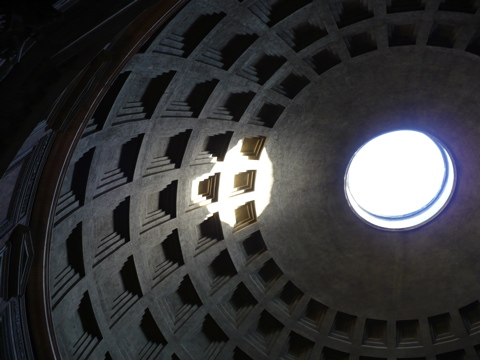

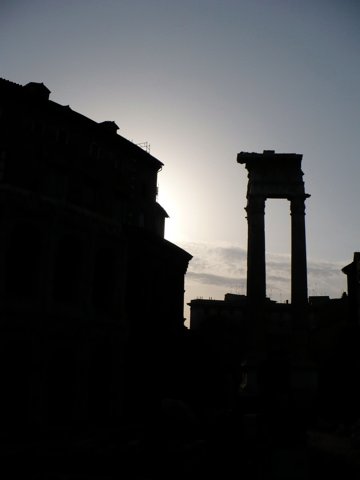
Pingback: Vidi « Archaeoastronomy
Wow, you’re not kidding about the SPQR thing. 2,000 pics on Flickr of manhole covers and drain lids (and some plaques and statuary). I think that’s kind of neat. Lends an air of continuity. When the Empire rises again, they won’t have to change any infrastructure.
LOL, that’s a fair point! In Rome’s defence I might have added that, apparently, the city does still have a senate (it’s the name of the city council), and that a number of other European cities also have SPQ[insert initial(s) here] on their city property.
Pingback: Airminded · Rome 1b
Pingback: Airminded · Rome 2a
The Roman Empire was founded by Dacians, ancestors of the Romanian people.
Sorry, you appear to have come to the wrong place! The other Romanian nationalists are over here.